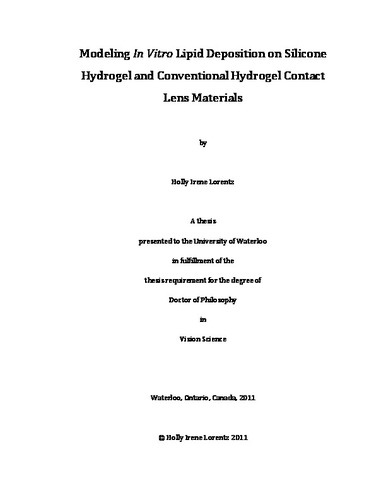Modeling In Vitro Lipid Deposition on Silicone Hydrogel and Conventional Hydrogel Contact Lens Materials
| dc.contributor.author | Lorentz, Holly Irene | |
| dc.date.accessioned | 2012-01-12 19:39:46 (GMT) | |
| dc.date.available | 2012-01-12 19:39:46 (GMT) | |
| dc.date.issued | 2012-01-12T19:39:46Z | |
| dc.date.submitted | 2011 | |
| dc.identifier.uri | http://hdl.handle.net/10012/6454 | |
| dc.description.abstract | Purpose: To examine the variables that influence lipid deposition on conventional and silicone hydrogel contact lens materials and to build a physiologically relevant in vitro model of lipid deposition on contact lenses. Methods: Lipid deposition on contact lens materials can lead to discomfort and vision difficulty for lens wearers. Using a variety of radiochemical experiments and two model lipids (cholesterol and phosphatidylcholine), a number of clinically significant parameters that may influence lipid deposition were examined. • The optimization and characterization of a novel artificial tear solution (ATS) was examined (Chapter 3) • Optimization of an extraction system to remove deposited cholesterol and phosphatidylcholine from various contact lens materials (Chapter 4) • The influence of different tear film components on lipid deposition was researched (Chapter 5) • The efficiency of hydrogen peroxide disinfecting solutions to remove deposited lipid from contact lenses was investigated (Chapter 6) • The effect of intermittent air exposure on lipid deposition was examined through the use of a custom built “model blink cell” (Chapter 7) Results: A novel complex ATS designed for in-vial incubations of contact lens materials was developed. This solution was stable and did not adversely affect the physical parameters of the contact lenses incubated within it. An efficient extraction protocol for deposited cholesterol and phosphatidylcholine was optimized based on chloroform and methanol with the addition of water and acetic acid for phosphatidylcholine extraction. Overall, cholesterol and phosphatidylcholine deposition is cumulative over time and found to deposit in greater masses on silicone-containing hydrogels. Cholesterol and phosphatidylcholine deposition is influenced by the composition of the incubation medium and air exposure which occurs during the inter-blink period. Hydrogen peroxide disinfecting solutions were able to remove only marginal amounts of lipid from the contact lenses, with the surfactant containing solution removing more. Conclusion: This thesis has provided hitherto unavailable information on the way in which lipid interacts with conventional and silicone hydrogel contact lens materials and the in vitro model built here can be utilized in various ways in the future to assess other aspects and variables of lipid and protein deposition on a variety of biomaterials. | en |
| dc.language.iso | en | en |
| dc.publisher | University of Waterloo | en |
| dc.subject | Contact Lens | en |
| dc.subject | Lipid | en |
| dc.title | Modeling In Vitro Lipid Deposition on Silicone Hydrogel and Conventional Hydrogel Contact Lens Materials | en |
| dc.type | Doctoral Thesis | en |
| dc.pending | false | en |
| dc.subject.program | Vision Science | en |
| uws-etd.degree.department | School of Optometry | en |
| uws-etd.degree | Doctor of Philosophy | en |
| uws.typeOfResource | Text | en |
| uws.peerReviewStatus | Unreviewed | en |
| uws.scholarLevel | Graduate | en |

